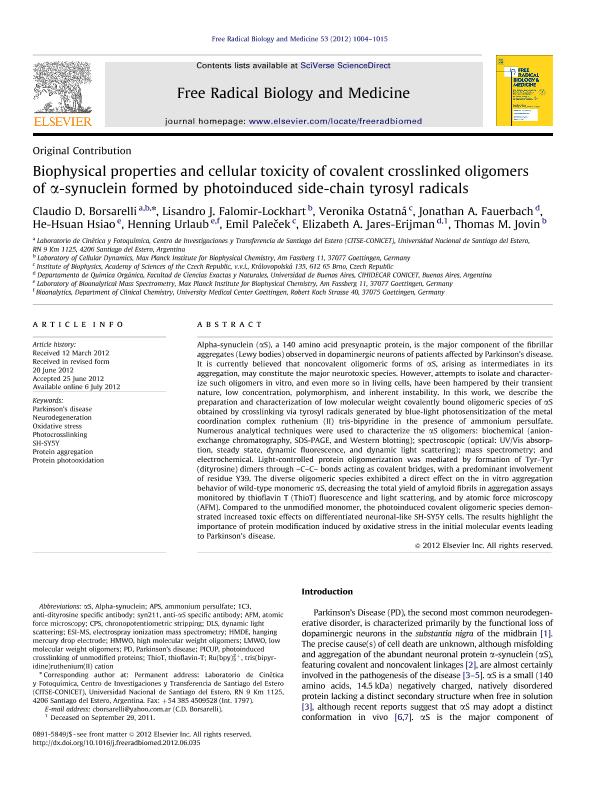Artículo
Biophysical properties and cellular toxicity of covalent crosslinked oligomers of α-synuclein formed by photoinduced side-chain tyrosyl radicals
Borsarelli, Claudio Darío ; Falomir Lockhart, Lisandro Jorge
; Falomir Lockhart, Lisandro Jorge ; Ostatná, Veronika; Fauerbach, Jonathan Arturo
; Ostatná, Veronika; Fauerbach, Jonathan Arturo ; Hsiao, He Hsuan; Urlaub, Henning; Palecek, Emil; Jares Erijman, Elizabeth A.; Jovin, Thomas M.
; Hsiao, He Hsuan; Urlaub, Henning; Palecek, Emil; Jares Erijman, Elizabeth A.; Jovin, Thomas M.
 ; Falomir Lockhart, Lisandro Jorge
; Falomir Lockhart, Lisandro Jorge ; Ostatná, Veronika; Fauerbach, Jonathan Arturo
; Ostatná, Veronika; Fauerbach, Jonathan Arturo ; Hsiao, He Hsuan; Urlaub, Henning; Palecek, Emil; Jares Erijman, Elizabeth A.; Jovin, Thomas M.
; Hsiao, He Hsuan; Urlaub, Henning; Palecek, Emil; Jares Erijman, Elizabeth A.; Jovin, Thomas M.
Fecha de publicación:
07/2012
Editorial:
Elsevier Science Inc.
Revista:
Free Radical Biology and Medicine
ISSN:
0891-5849
Idioma:
Inglés
Tipo de recurso:
Artículo publicado
Clasificación temática:
Resumen
Alpha-synuclein (αS), a 140 amino acid presynaptic protein, is the major component of the fibrillar aggregates (Lewy bodies) observed in dopaminergic neurons of patients affected by Parkinson?s disease. It is currently believed that noncovalent oligomeric forms of αS, arising as intermediates in its aggregation, may constitute the major neurotoxic species. However, attempts to isolate and characterize such oligomers in vitro, and even more so in living cells, have been hampered by their transient nature, low concentration, polymorphism, and inherent instability. In this work, we describe the preparation and characterization of low molecular weight covalently bound oligomeric species of αS obtained by crosslinking via tyrosyl radicals generated by blue-light photosensitization of the metal coordination complex ruthenium (II) tris-bipyridine in the presence of ammonium persulfate. Numerous analytical techniques were used to characterize the αS oligomers: biochemical (anion-exchange chromatography, SDS-PAGE, and Western blotting); spectroscopic (optical: UV/Vis absorption, steady state, dynamic fluorescence, and dynamic light scattering); mass spectrometry; and electrochemical. Light-controlled protein oligomerization was mediated by formation of Tyr?Tyr (dityrosine) dimers through ?C?C? bonds acting as covalent bridges, with a predominant involvement of residue Y39. The diverse oligomeric species exhibited a direct effect on the in vitro aggregation behavior of wild-type monomeric αS, decreasing the total yield of amyloid fibrils in aggregation assays monitored by thioflavin T (ThioT) fluorescence and light scattering, and by atomic force microscopy (AFM). Compared to the unmodified monomer, the photoinduced covalent oligomeric species demonstrated increased toxic effects on differentiated neuronal-like SH-SY5Y cells. The results highlight the importance of protein modification induced by oxidative stress in the initial molecular events leading to Parkinson´s disease.
Archivos asociados
Licencia
Identificadores
Colecciones
Articulos(CIHIDECAR)
Articulos de CENTRO DE INVESTIGACIONES EN HIDRATOS DE CARBONO
Articulos de CENTRO DE INVESTIGACIONES EN HIDRATOS DE CARBONO
Articulos(INIBIOLP)
Articulos de INST.DE INVEST.BIOQUIMICAS DE LA PLATA
Articulos de INST.DE INVEST.BIOQUIMICAS DE LA PLATA
Articulos(SEDE CENTRAL)
Articulos de SEDE CENTRAL
Articulos de SEDE CENTRAL
Citación
Borsarelli, Claudio Darío; Falomir Lockhart, Lisandro Jorge; Ostatná, Veronika; Fauerbach, Jonathan Arturo; Hsiao, He Hsuan; et al.; Biophysical properties and cellular toxicity of covalent crosslinked oligomers of α-synuclein formed by photoinduced side-chain tyrosyl radicals; Elsevier Science Inc.; Free Radical Biology and Medicine; 53; 4; 7-2012; 1004-1015
Compartir
Altmétricas



